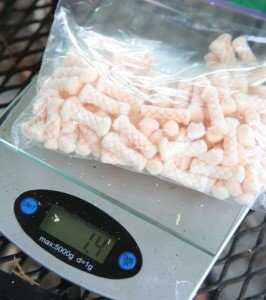
And the winner is…? These Sparklite USGI firestarters are both cheap and light, and they start right up when one spark hits them. This is a bag of 100, which is under $20.
Resources:
Sparklite Government Issue Tinder – $18.95/100 on Ebay
FireCrackle Fire Starters – $7.25/10 ($52/100) on Ebay
Self Igniting Firestick – $9.85/6 on Ebay
Ferrocium Stick & Striker – 99 cents on Ebay
Fresnel Lens Magnifier – $21.46/5 Pack on Ebay
One of the most embarrassing moments for a prepper is not being able to light your Rocket Stove with a butane lighter stick after half an hour. And since this has happened to me a couple times, it got me to thinking about what I would have to go through on the road, trying to cook dinner. Sticks, leaves and even pine needles on the ground absorb water. They may look dry, but try to light them and have them stay lit. So I went looking for firestarting help, and I found some pretty good options. The most important thing is that I tested them with a “flint and steel,” because matches get wet, and you run out of matches. In an afternoon of trying to start fires, I ended up with a sore arm and some good experience with what of my experiments worked, and which ones didn’t.
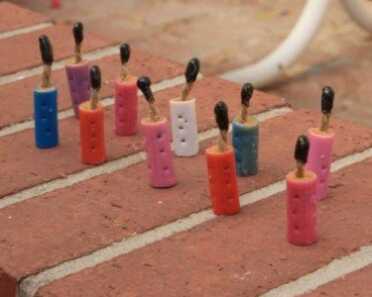
A close runnerup are these FireCrackle Firestarters (video below). They are light, waterproof, and they will dry out wet wood that you find on the ground because they burn a long time.
Regular readers of this column know that I find a lot of oddball stuff on Ebay, and this article is no exception, but at the same time I also try to go to Walmart and see what they have for cheap. Sometimes you can’t beat Walmart, and camping section is loaded with firestarting tools, waterproof matches, fuels, etc. I am planning an upcoming article on fuels as well, but for this one I wanted to focus on the firestarters, because for a lot of us, sticks in a Rocket Stove is really a free source of unlimited fuel, but you have to light it. I was surprised to find the huge array of products that you can buy just for starting fires. This is partly because there are now quite a few products that are for starting charcoal without lighter fluid. Of those alone there are dozens now if you look on Amazon, and I was able to test a pretty good one I found at Tractor Supply. For the most part, lighting fires with a “flint and steel” isn’t easy, period, but I did find some stuff that works great, and it is linked above. I also tried a sun magnifier, and I’ll get to that below as well.
The problem I see with lighting fires in a survival situation is that you can never have enough options, because you have no idea how long you’ll be lighting fires. i wouldn’t be using up gas in the lawnmower. Save it for your Zippo. I don’t know that there is even a match factory left in the United States. Personally I have a pile of Bic lighters in my survival stuff, and sparkers, and a whole case of matches. This article is really about not having matches, but don’t think I’m saying this is a first option. Lighting a fire with sparks and tinder, without any of these specialty tinder products, is really hard.
Magnesium vs. Ferrocium
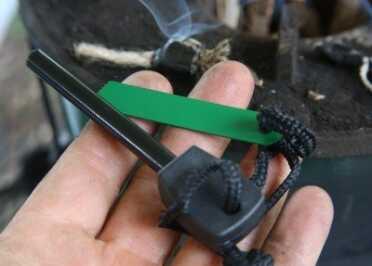
This black rod is a ferrocium rod, not a magnesium rod. The “magnesium” firestarters are the ones with the silver block shown below in the photos. These are 99 cents each on Ebay, shipped.
I got really confused at first as I started to research this article because I know the old “flint and steel” tool as a “magnesium firestarter.” We’ve all seen them. They look like a silver block with a black rod on the side, and they come with a piece of steel. I had never realized that the brick part of the tool is the magnesium, and that you are supposed to scrape some of that off unto your tinder. Then you scrape the black rod to make the sparks. But if you look at the firestarting rack at Walmart, there is also just a black rod tool, and it doesn’t have the magnesium block.
The black stick is ferrocium. As you can see from the pictures, I chose to use one of the thick ferrocium stick starters for most of my tests. My experience so far is that I must not have firestarting mojo, because it isn’t easy to repeat a process whatsoever. The ferrocium rods, and this goes for the small ones and the big ones, don’t seem to have a formula for when they spark and when they don’t. I tried to scrape a little first, tried to scrape back and forth, angled the striker, fast, slow, long, short, etc., but sometimes the steel scrapes pieces off, and sometimes it sparks. This makes the rod wear away in large peels without much control over how much rod you are losing whatsoever. I don’t get it.
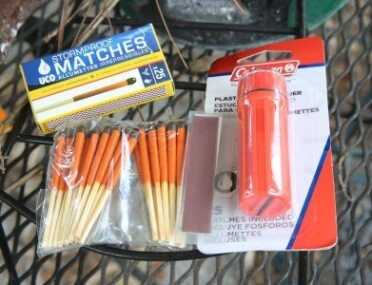
You can get both windproof matches and waterproof match cases at Walmart, or online, and they are cheap. This article is about using a sparker, and using the sun, but don’t discount common sense supplies.
When the ferrocium sparks, it sparks big, especially with the thick ones. But that isn’t enough for some materials, even with repeated direct hits. On some of my tests I couldn’t get the tinder started at all, but the side of my test pan got scorched, and I could no longer hold the steel because it got so hot.
So lesson number one for me was that my firestarters need to start really fast. Otherwise I end up wearing away my ferrocium rod, and it really gets frustrating because I kept knocking the tinder pile away as I tried to get the sparks, or slivers, right on top of the tinder. So frustrating! I strongly suggest that you get a bunch of these things and go try them. Do not go buy these at Walmart though! The one with the green steel is on Ebay for 99 cents, shipped from China. You can also get ferrocium rods in bulk packs of 40 for about the same price.
And The Winner Is?
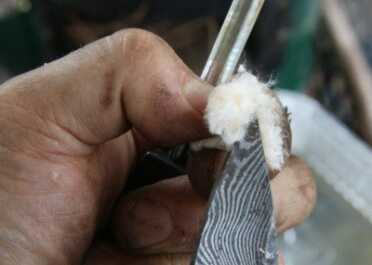
I didn’t have one failure with these Sparklite firestarters. I fluffed the ends with a knife before sparking and they caught right up.
What I found was that in order to get something to light from just sparks, it has to have some whispy material to it, preferably a sort of plastic or natural fiber. My best find was Sparklite government issue tinder, which I found for – $18.95 per 100 on Ebay. They are light as feather, tiny, and they ignite with a hot spark reliably, every time. Sparklite is a plastic of some sort, and in short order it turns into a bubbling glob of burning goo, so be careful where you burn it. The nice thing is that if you are starting dried but damp wood or leaves, it burns for a while in order to dry the tinder out and start it. Hands down this is the best product I found.
My second choice is called the FireCrackle, made by a DIY Ebayer named James Tawatao, who actually has his own Youtube Channel, and I’m embedding the FireCrackle video here as well. They aren’t as cheap, $7.25 for 10 on Ebay, but he automatically combines shipping, so the cost of 100 would be like $52. They burn for significantly longer than the Sparklites, but they aren’t as easy to light. James has what I think is a novel idea for his firestarters. Rather than expect a material to be waterproof, he encases it in a pine pitch coating which is hard. You crack it with the back of your knife, and even if the firestarter got wet, you have a nice dry fuzzy thing that will catch from sparks.
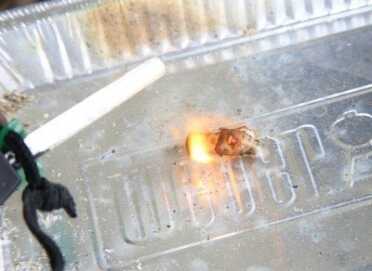
The little piece of fluffy rope turns into a burning blob of plastic pretty quick, and it stays burning for a couple minutes.
I also tried his Self Igniting Firestick, which is $9.85 for 6 on Ebay. This is a really novel little product, and not easy or quick to make. James takes two strike on box matches and embeds them in the plastic shell with jute twine. You crack off the cap, and he has a little bit of foil and twine protecting the heads of the matches. Inside the covering tape is a little square of sandpaper to strike, and hey, they actually work. Note that the original “strike anywhere” matches were banned because the coating became labelled as hazmat, and the “green” ones stink. I have some.
My first test with James’ products was his FireBomb, which I didn’t have as much success with like he does on his video. But on watching the video again, I went back and tried another and pounded it out with a rock as well as he did, instead of just the back of my knife blade. The FireCrackle’s didn’t need to be pounded out that much to be frizzy. And the one self igniting firestarter that failed also didn’t need need to be pounded out to light right up from sparks. If you buy the FireBomb, the Fatwood Sticks, or the candle with the pitch covered wick, you really need to pulverize them to fluff them up properly.
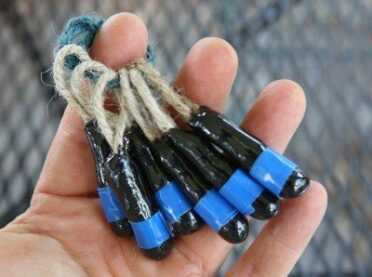
I also tried these self igniting FireStick firestarters. They contain two matches, wrapped with pitch soaked jute twine and encased in hard pine pitch.
Now for the losers. It was clear from even basic testing that commercial firestarters expect a flame to be present, from a butane lighter stick. The Duraflame products didn’t even ignite right away on putting a burning firestarter next to them. Total dud of a product for survival fires. The charcoal lighting Tumbleweeds that I got a Tractor Supply are a great product, but not for lighting fires alone from just a spark rod. They do roar in the Rocket Stove once they are lit, and they light right up when touched with a flame. Unfortunately I haven’t the Tumbleweeds for sale for less than $12 for 16 of them online. They were a monthly special and now they are on clearance, probably gone until next summer.
Surprisingly, one of things that actually worked reliably was the first firestarting material known to mankind. It is called Amadou, and it is made from a fungus that grows on trees. These days Amadou is mostly used for fly holders for fly fishermen, and they actually make felt hats out of it. I was able to get some of these felt scraps on Ebay (not cheap) and you’ll see my experiments in the pictures. They have found Amadou in old campsite excavations from a thousand years ago. Cool stuff.
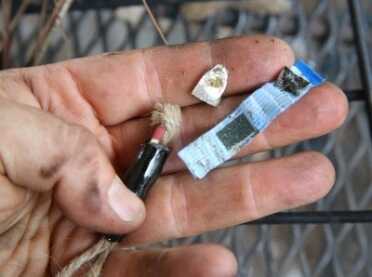
You crack off the tip of the pine pitch shell and the match heads are inside foil and twine. You strike the matches on a little piece of sandpaper in the tape.
I also tried some Fatwood dust, and Fatwood shavings from James. He gets these things going with just sparks in his videos, so maybe I just need practice. This is a man who takes firestarting seriously, and I really respect him for such a thorough job at making these products and making them accessible to the public. Fatwood is something I had never heard of before, and I have to say that my bags of Fatwood dust and shavings were left in a hot truck for a week or so in the Florida sun. As you’ll see in the pictures, the Fatwood does catch up to high flames really fast once it catches, but I was unable to get either the dust or the shavings going with just sparks.
This column is about a survival budget, not just surviving. I think James’ products are really cool, and I did buy some. But my first suggestion is to buy the Sparklite in bulk. I did, and I have already put a bag of them with a sparker and a box of matches with each of my cooking options for survival. I’m not throwing out James’ firebombs and fatwood dust. With wet wood they will come in really handy.
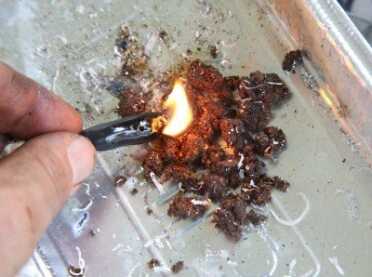
The Duraflame blocks, even when crumbled up, didn’t even catch with a direct flame quickly, never mind with sparks.
I will also mention here that I bought a big bag of pre-shaved magnesium, thinking that mixing it with the dust and shavings would give me and easy fire start. That is a big no, and the magnesium was a complete waste of money. In theory it’s a great firestarter, and I suppose it is better than nothing, but it didn’t help me start anything.
The same goes for steel wool and cotton balls. I have said many times in this column to beware of anyone who says “You can just…” when the give advice about survival. Those are comments I have seen on other firestarting articles, and they are not easy options.
Char Cloth

This picture is a pretty good representation of how Char Cloth works. This is a military firestarter, and it sparks pretty reliably. When sparks hit the Char Cloth they spread instantly, and you can blow on it to ignite tinder.
The only other somewhat easy success I had was with what is called char cloth. You can Google how to make it. It’s pretty easy. You put squares, or a roll of cotton cloth in a sealed can, like an Altoids tin, and put a small hole in it. Then you heat the can on a flame until the cloth is black. It’ll take you a couple tries to get the timing right. The resulting black cloth catches with just a spark, and smoulders. If you cover the cloth with tinder, like the Fatwood shavings, it catches right up when you blow on it. Good stuff, and sustainable, because you can make new ones after your dinner as the stove burns down. James sells some Char Cloth and Char Rope, as to other Ebay sellers.
Making Fires with the Sun
I have been trying to make fires with a magnifying class since I was a kid. For years I used a big magnifying glass as a woodburner. But when it comes to making an actual fire with flames, and not just making wood smoke and turn darker, good luck. I’ve never been able to get it to go reliably.
That was why, when a “survival fresnel magnifier” came up on my suggested other items on Ebay (something GA could use), I laughed. But, because it is my job in this column to fail as well as succeed, I ordered some of the 2″ x 4″ size, which is meant to go into a survival kit. Then I saw the bigger size, 7″ by 10,” and ordered that too.
The 2 x 4 was a dud. In bright South Florida sun it did no more than smoke the Fatwood dust and shavings. Then I tried the 7 x 10, and OMG, it’s like a Light Saber. You can get a 5 pack of the large Fresnel Lens Magnifier for $21.46 on Ebay. I don’t suggest that anyone rely on these things, but check out the pictures. I even lit a regular stick off the ground into open flame in like 2 seconds. Go buy some! They won’t work when they are heaving spraying the Solar Radiation Management geoengineering trails, but hey, free fire when you can grab it is free fire. They totally rock so try them where you live.
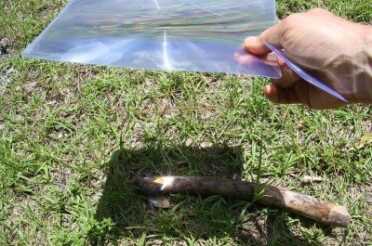
The large magnifier could light anything even slightly dark colored. The military firestarters didn’t even get warm though. This stick burst into flames in like 5 seconds in the direct Florida sun.
Lots O’ Photos
This is as much a photo essay as anything, so please check out the long list of pictures and captions. If you haven’t tried to light fires from materials you pick up off the ground, try it. At least 3 times that I can remember it started raining just before I needed to go start looking for sticks for my Rocket Stove. You’ll see it isn’t easy. Any headache that you can save yourself cheaply I say is a headache you should plan to not have, and I would plan to grab some firestarters. Ten years early is better than one minute late.
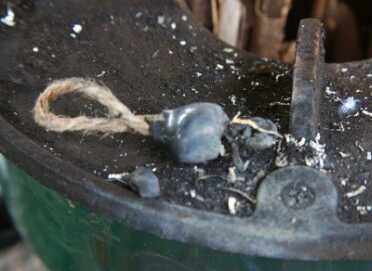 I didn’t have as easy a time with the FireBombs. You really have to pulverize the wicks on them to fluff them up because they are soaked with pitch. This one is covered with residue from being battered with sparks for ten minutes without lighting. I had broken it up with the back of my knife. Later I smashed this wick with a stone and it lit right up. | |
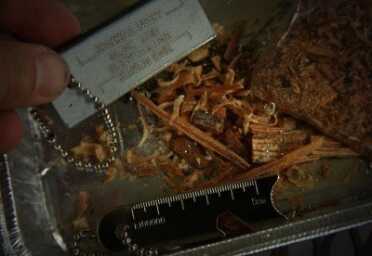 On a standard military firestarter, you scrape away the magnesium block first, then strike the ferrocium rod to spark. These are likewise on Ebay cheap cheap, less than $4 each in quantity. | |

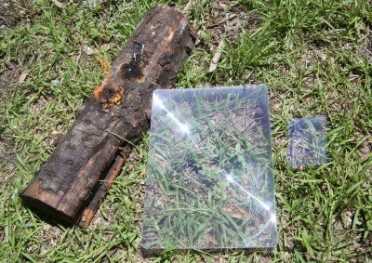
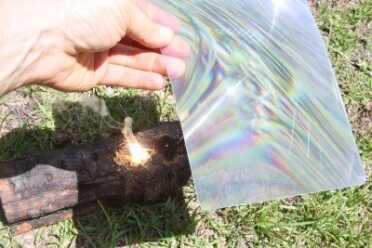
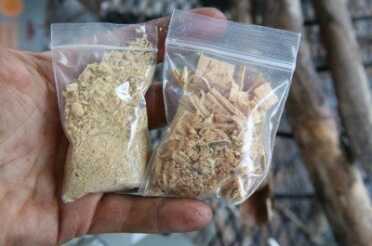
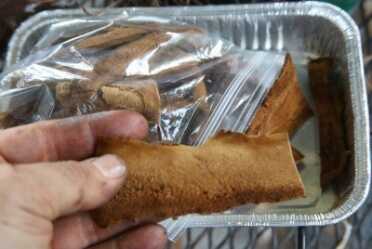
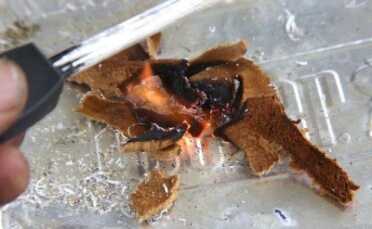
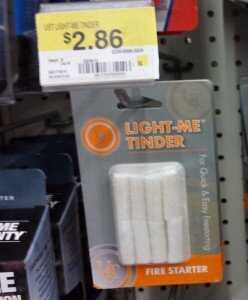
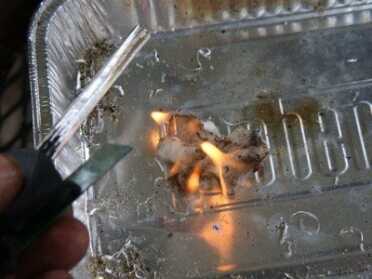
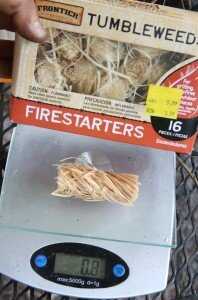
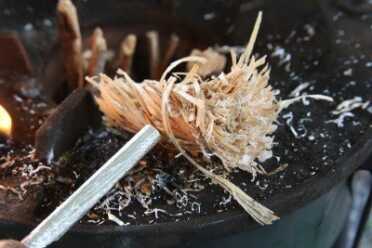
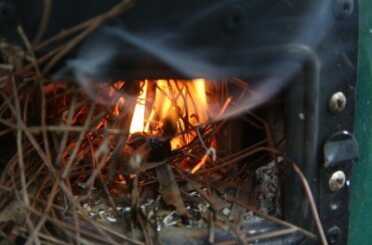
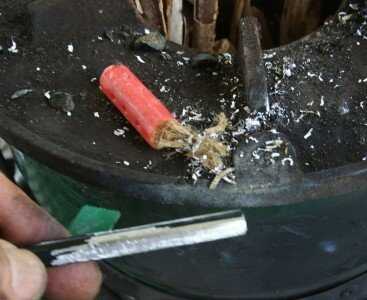
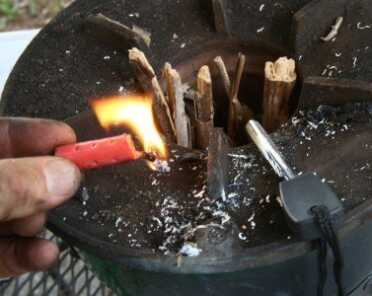
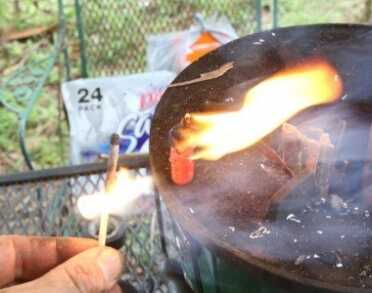
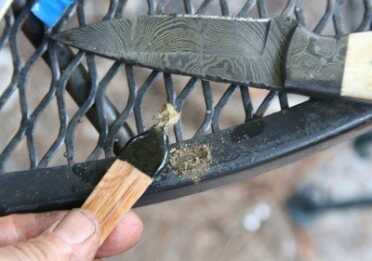
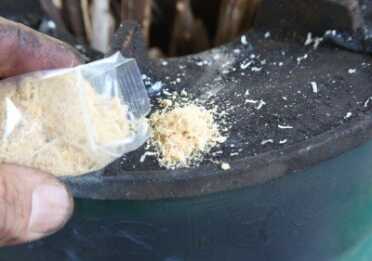
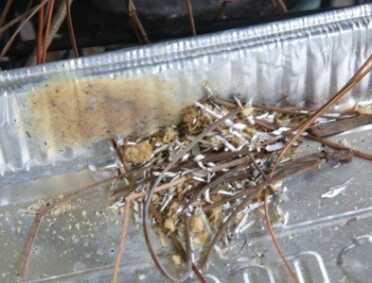
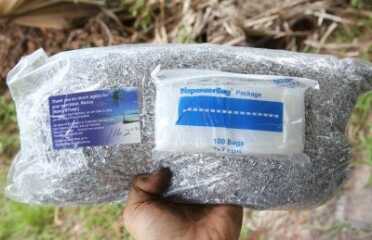
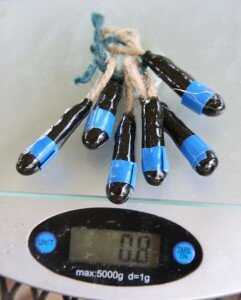
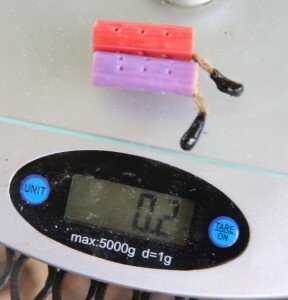
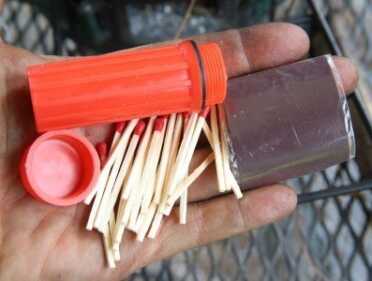
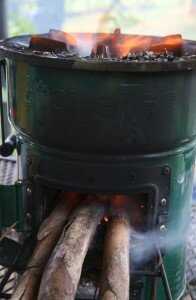
Don’t rely on any article or written direction for survival tactics of any kind unless you, yourself, explore the methods. Just because someone else can do something with identified methods and/or equipment or ingredients at a particular time and under a particular circumstance doesn’t mean you can also. And something that works fine in the garage or kitchen table for you doesn’t mean that it will work in the Brooks Range, north of the Arctic Circle, in blowing freezing rain when you need it the most, as I found out with two new Bic”s and chapstick and cotton from my pill bottle. Damn good thing they still put matches in MRE’S. All of the mentioned fire starting methods include items you need to HAVE with you (carry) when you need them. Even when we teach making and using a fire-bow, we mention first that it is important you see if you have the needed string/cord BEFORE you start as you’re probably not going to have time nor the training to make/find, cordage, gut, twisted hide, etc. And if you have to BUY your own char-cloth, well you don’t need to be in the “bush” anyhow…. my opinion, your mileage may vary..
I use a very simple plan – take cotton balls and dip in Vaseline. melt a small amount in a tin can or cup and dip and dry. Store in a ziploc baggie and they are good forever. BTW, you can but a few dozen bic lighters at Walmart and include one in each baggie, problem solved!
Anyone ever Try a 9 volt battery and steel wool?
As a Boy Scout we used to take the little lunch packets of Fritos corn chips to use as starter. The oil in the chips set the campfire off right away and we got to eat the chips we didn’t use on the bus ride home. Light a corn chip up sometime and see how they burn. They are super cheap too in comparison to many other forms of fire starter!
Yeah but you couldn’t start them with a spark I don’t think.
If you really want to use the sun, then check out the SOLAR FIRE STARTER SOLAR LIGHTER & SURVIVAL TOOL
http://store.sundancesolar.com/solar-fire-starter-solar-lighter-survival-tool/
It is a small affordable addition to your survival kit, bag, etc. As long as there is sun you have fire!
You can by it on Amazon or the Sundance website.
Check it out- Rich
P.S. – Sundance also has some great Do-It-Yourself Solar Kits for when the grid fails!
Liked your article and information was very helpful. But am curious, how come no word on the Fire Piston Fire Starter? You can make your own, or buy them on Ebay: http://www.ebay.com/bhp/fire-piston
In response to your comment that the ferrocium rod did not produce consistant sparks. I have two Bear Grills survival knives both with a ferrocium fire starter rod attached to the knife sheath and both of them produce a BIG array of sparks every time it is dragged over the back side of the knife blade. I have used both of these knives to start fires with Vaseline soaked cotton balls and it is easy to do. Another good item to easily get a fire going is a trioxane bar. These things light up as soon as a single spark hits them and burn hot for several minutes. Also, need a “match” that will always light? Try a forever match (or what ever they are called in your area). Add a few drops of lighter fluid, screw the match back into it and every time you take it out and strike it on the striker strip it lights. Will keep doing this for a long time and when the lighter fluid eventually dries up just add a few more drops and ready to go again.
I know very little about starting a fire, but I sure got some great ideas from this article, and you guys’ comments on how to start a fire. I’m an old fart, but I’m new to this TSHTF stuff, but I’m learning! Sometimes the comments are more valuable than the articles. Keep ’em coming guys!
I think the article was very good but as the ” SURVIVAL” term keeps getting shoved in commentators faces, where is the part about starting a fire with your bare hands? How about starting a fire with a knife as your only tool? Readers don’t need to drink the Doomsday Prepper kool-aid to be interested in survival fire starting or commenting on it. You did an entire article on survival and rebuilding CDs and reference publications. Someone references his success with Boy Scout Handbook and you lash out!
You also discredit other methods that are widely used but you won’t use or can not make them work. Yet, you also had trouble with James Tawatao’s products that he started with ease. Could it just be operator inexperience?
Its natural to take pride in your work. Your vested in it for time, resources and desire to put forth an outstanding Article. Your replies to some of the sincere comments were …….. I’ll just say they set a poor example and detract from your ByLine and the Guns America. You are better then that and you readers deserve better too.
The best fire starters I ever made were simple cotton balls dipped in petroleum jelly and flattened to the size of a quarter.
These puppies flame up with the least of a spark. I saw this done by Don Shipley in one of his extreme seal experience videos and tried it. Cheap as hell and you can make a pile of em for little to nothing. I keep them in a zip lock bag.
I’ve always been curious about the fire piston. A quick search will yield several examples. I’ve never tried one and I think it would be a good addition to your fire-starting tests.
Never heard of it but totally getting some, thanks.
I suggest adding a Fire Piston with your char cloth. You can get it started any time of day. Of course you still need a dry fuel source.
OMG two fire piston comments. We’re on it!
The”Amadou” is Fomes fomentarius, a fungus found growing on dead hardwoods, especially birch. The common name is “tinder polypore”. These hoof-shaped fungus are very common and have been used for thousands of years to start fires. They smolder forever and are also used to transport fire from one sight to the next. A woman I know lit a piece to experiment with. She then threw the smoldering fungus outside into 2 feet of snow. 2 hours later, the fire department arrived to extinguish her flaming deck.
Preppers would do well to learn 1/2 dozen or so easily recognized mushrooms for both medicinal and nutritional values. The skin of the Birch Polypore can be used as a self-adhering band-aide and has antiseptic properties.
I used too teach a survival class that was for teens. We used cardboard egg cartons filled with wood sawdust, and soaked them in paraffin. That is cheap and reliable, lasts for a while when lit to dry wet tinder and enhance the effort. I know of one student stranded in deep snow in the winter woods who used one and credited it with making a life threatening situation into a camp out.
Paul, nobody can ever fault you for not being thorough, thanks for another great in-depth, comprehensive and practical, article.
Local ‘Pioneer Village’ guy stopped by here once and amongst topics we’d visited on was his little shoe polish pin-holed can with char cloth and piece of flint rock inside. Single spark from his first knife strike, he had a fire started, repeatedly every time. Gotta love that KISS principle. That tiny can, maybe containing a few other favored tricks from above, is all one would ever need, IMO. That, and actually getting practical experience doing it in widely varying humidity/cold/wind/fuel conditions. Reminds me, too, of growing up winter camping in NE, with fingers quickly losing dexterity in the cold, if not simple/easy/fast you can quickly pass point of no return where you can’t start any fire regardless what you have to work with then.
– Shane
I have found that when using a magnesium fire starter and or ferrocium rod it is better not to use a knife or that piece of hacksaw blade that comes with it. I use an open pair of good steel scissors (that you should already have in your prepper supplies) held in the left hand and scraping with the cutting edge. Left handed is important because of the angle of the cutting edge.
000 steel wool and a torch spark lighter never fails.
99% if these fire starters take buying it in ebay or wallmart or something like that.
One year after TSHTF they will be all used up and there wont be a wallmart open.
Learn now how to use a bow drill or compression ignition, or flint and steel along with naturally occurring tinder.
The depth of the average person’s contemplation of a global SHTF event is as shallow as their breath on a cold mirror. This includes gov. emergency management planners. We plan for temporary inconveniences like winter storms, hurricanes, and earthquakes – local and regional disasters. Recovering from major disruptions of critical national and global critical resource supply chains and services is essentially unimaginable – and consequently unmanageable.
Few understand how a major collapse can cascade downhill to a point that a restart of an advanced industrialized civilization is next to impossible and even if possible – will take generations. Industrialized civilizations are built in technological layers – one layer, or one discovery on top of another. Unfortunately, the technical ladders between layers of technological advancement is either pulled up to the next as it is built, or lost through simple neglect as new layers are added – fire starting skills being one example of many. For example, how many people still have a well preserved printed encyclopedia? How many of you know of or own the FoxFire book series? Who can build a two stage steam engine, or a basic generator? Only 2% of petroleum produced today goes to petro-chemicals, but 95% of global food supplies are dependent on those petro-chemicals. Ever try to restart an oil refinery to supply fuel and petro-chemicals without that fuel first in hand for a dependable oil transport system to said refinery? Our technologies are not only interdependent, but their evolutionary basis may have long been lost – restarting them essentially impossible without starting from scratch.
We aren’t preserving records with necessary durability of how we got here historically, much less technically, or economically. We think the Great Library of Alexandria was a technological and cultural loss, but at the time 95% of the world’s peoples weren’t even aware of its loss, but when and if the electric lights ever go out across our modern world, at least 95% humanity will be affected and they will be out for a very long time. The world will be a far darker place than when the Great Library fires died out.
Cotten balls covered with Vaseline stored in a zip lock bag. Strike fires real easy. Long burn. Waterproof. Lightweight. Cheap. What more do you need?
If you want to buy something multi-purpose, get Fire-Chord. Made from 500 parachord with a center filliment that ignites easy.
Strange you left out these two options.
WOW, I am totally amazed at the number of so called hunters and campers who don’t know how to start a fire. My best recommendation is to buy a current Boy Scout Hand Book. Every Scout has to learn how to build a fire using tools at hand. Simple fire starter materials you should always carry (Clothes Dryer lint, Steel wool, Candles, Chard Cloth, even FAT wood) in a small zip lock bag. You can include a small Magnifying class, flint and steel, even water proof matches (which you can make yourself). I am constantly surprised at the real ineptness of so called modern day hunters in not bothering to learn the basics. When I lived in Oregon I remember calling on these basic skills several times when hunting. Finding fire wood in the rain is not hard if you know what you are doing. I was taught this over 60 years ago in the BOY SCOUTS. Half of these Big Hunters don’t even know how to use a simple compass and map. They rely on a GPS. Unfortunately lots of places you can’t get a good GPS signal (in the mountains or canyons). Basic Scout Craft can save your life. Read the BSA book and take a weekend and practice how to build a fire with the essentials you bring along in a small zip lock bag. Learning how to use a Map and compass will take a bit longer but it’s not hard. I was amazed at the number of second Lt.s who constantly were lost in Viet Nam and could not find there ass with both hands. Learn how to find your way not only with a map and compass but with out them (also in the BSA handbook), in daylight or dark. If you have kids make sure you teach them or better yet have them join the BOY SCOUTS, then have them teach you!
An OLD TIME SCOUTER.
BFCO75
This is a classic “you can just” comment. Read this and “you can just” do what it says. Go try to start a fire with dryer lint. Go try to keep your stuff dry in a ziplock bag, which IS NOT WATERPROOF. In fact modern reverse osmosis water filters use that very plastic to filter water, because it is very porous. Simple things you can carry still involves deciding what to carry.
I love the way you simply dismiss comments, with the wave of your “you can just” response. It would be more helpful to instead, explain that many methods of lighting fires, require practice in various conditions. In the scouts we learned to make fires many ways, but we actually practiced these methods over and over. That way we learn what works and what doesn’t. At home, something as simple as lighting the BBQ charcoal, is done using different ignition methods. When we finally need to start a fire in less than desirable conditions (which we have a multitude of times), it’s not a huge problem as we’ve done it many times before. In fact we love rainy and snowy weather camping, as we love practicing our skills. When you can go out with confidence, into a wet forest, find dry kindling etc., and maybe use flint and steel to start your fire, it’s a great feeling of success.
This column is about survival. It’s not a bunch of old guys showing kids how to tie knots and pretending that we still live in a great and noble country. This article took days of testing, hundreds of dollars in investment, and the burning of valuable survival resources, to help the dedicated readers skip over making the wrong choices on something they don’t understand. If you want to make a bonehead comment about dryer lint, which someone noted wholly depends on what type of fabrics you are drying, why shouldn’t you be challenged for talking out of turn to brag about your boyscout work? Comments like that are meant to get people to do nothing, which is exactly what you are doing to prepare for the end of this fake prosperity. Why should you get equal time without being challenged for peddling nonsense information that you spent zero time testing? Would you prefer that we just delete the comment, which is what it deserved?
It’s hard to understand you dismissing what I said out of hand, when I gave information that every survival instructor I know, says the same thing. Since when is advising someone to practice any skill peddling nonsense information? And how does telling people to practice, practice, practice encourage people to do nothing? Quite the opposite. I’m sure you’ve told people to practice their skills yourself. I teach hunter education and the concealed weapons course for the state of Arizona. I teach survival skills on the army’s Ft. Huachuca to both civilians and military personnel. I’ve prepared for the future. I’m also concerned about the fake prosperity, and am preparing for it’s end. I’m sure there are things we could learn from each other, if we spoke to each other, rather than made accusations and personal attacks, which say more about the accuser than about the accused.
Every survival instructor you know probably has never had to survive. They are peddling the same book advice without ever trying it themselves. Go take a piece of cotton ball or steel wool and try to start a fire with it using just a spark rod. Practice, practice practice wastes time and resources. Why not figure out what works and just go do that? And you are right, it does say something about the accuser. I don’t suffer fools. And because this column is more substantive and objective than any other survival column, youtube channel, or blog I have ever seen, I feel that I have a valid platform to instruct people that we don’t have to suffer self righteous fools in internet comments. Just because someone can comment doesn’t mean that they should. And yet you didn’t see any negative reaction to the guy with the Fritos, because it is something that he has actually done, and that actually does work good if you are dealing with wet tinder.
Don,
First I’d like to thank you for your service to our great country. Although I’m your age I didn’t serve. However the real deal of our generation know how to build a fire several ways. I always liked dryer lint but not limited to that. Let all the REMF’s fall by natural selection.
Regards,
Steve
One thing I learned years ago is that fat lighter, in order to light off easily has to be dry. Or should I say cured. I split mine into 1/4 strips and let it dry for a year. When to sap is wet it’s like trying to burn water. It has to be dry, then it will light right away.
I found this article most informative. Love all the suggestions and the fact you tried each one out and gave a solid report. Thanks
Dryer lint works great and is free.. If you want to make sure your dryer lint stays dry when usING for camping. Take an empty egg carton and fill each egg hole with dryer lint, then melt in some parifin wax.. After wax hardens just pop out of egg carton and store for when you are ready to use…
Dryer lint can be good, if clothing dried was primarily 100% cotton, but if a lot of synthetics in the mix, not so good.
Of all the so called fire starting techniques (also likely the cheapest) is this. I get ordinary cotton balls You can make them any size you desire but probably an inch or an inch and a quarter is fine. Then you melt some beeswax in a small can that is placed in a waterbath (small pot). Doing this prevents overheating (fire!) or the spilling of hot wax onto the stove. When the wax is melted, turn the stove off. Now pour some of the melted wax onto a square of aluminum foil (8×8) inches square. This is the surface you will roll the cotton ball around so that it is completely covered with wax, then set it aside to cool and harden. I tried this with paraffin and candle wax but they both crack easily so they might get wet in rainy weather. Now, to start a fire, gather your small kindling and progressively larger sticks; surround your area with rocks to prevent too much wind and spread of fire. Pull apart the wax-coated cotton ball then strike your ferrocium with the steel piece … a spark will instantly start the cotton to light accompanied by some gentle blowing and then surrounding this with your “nest” of tinder. The melting wax is like a candle burning and the cotton acting as a wick. The beeswax is soft and pliable and will not crack unless exposed to very cold weather. I have tried this many times, and it always works. There is no need to collect, buy, or prepare any other type of afore mentioned products ! Let me know how this works out for you. Questions welcome, Thegourd
For survival, also use cotton balls soaked in ordinary Vaseline. melt a small mount in a tin can or cup and dip the cotton balls into the liquid. starts easy, burns a long time! Store in a ziploc baggie and good forever.